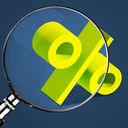Maybe high rates aren't slowing the economy much, after all

The Fed's strategy over the last two years has been to push interest rates upward to the point that they are restrictive, slowing down economic activity. But robust growth in the face of those higher rates is raising new questions about just how restrictive these rates really are.
Why it matters: If rates north of 5% aren't enough to slow the U.S. economy — as was the case in 2023 — it raises the possibility that the world is in a new normal, with persistently higher borrowing costs than prevailed in the 2010s.
- If true, those betting on big rate cuts soon could be disappointed.
- It is a potential downstream effect of large U.S. fiscal deficits, plus demographic and other shifts in the global economy.
Driving the news: The current data "suggests to me that the current stance of monetary policy… may not be as tight as we would have assumed given the low neutral rate environment that existed before the pandemic," said Minneapolis Fed President Neel Kashkari in an essay published this morning.
- "It is possible, at least during the post-pandemic recovery period, that the policy stance that represents neutral has increased," Kashkari wrote.
- The implication of that, he wrote, is that it allows the Fed more time to assess incoming data before cutting rates, "with less risk that too-tight policy is going to derail the economic recovery."
Former Treasury Secretary Larry Summers — who was early to identify "secular stagnation" that kept rates low through the 2010s — is also arguing that things have changed.
- "We've got an economy with a lot of underlying strength at interest rates where that would have looked unlikely some time ago," Summers said on "Wall Street Week."
- "One would want to be guessing that Treasury bill rates will be averaging well above 3% through the rest of this decade," he said.
State of play: As of November, the median official on the Fed's policy committee saw their policy at only 2.5% in the longer-run — however, three officials penciled in 3.5% or higher.
What they're saying: In his news conference last week, Powell noted that the neutral rate is "not something you can identify with any precision."
- "You look at the economy, and you say this is an economy that grew 3.1% last year. And you say, what does that tell you about the neutral rate?"
- "What's happening, though, is the supply side has been recovering in the middle of this. So that won't go on forever," Powell said.
- If the neutral rate has risen, "we're not really going to know that," he said in December. "People will be writing papers about that 10 years from now and still fighting about it … it's going to be uncertain."